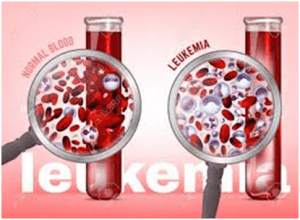Introduction and General Overview
Leukemia is cancer of the body’s blood-forming tissues, including the bone marrow and the lymphatic system which affects the production and function of blood cells. It could cause weakness, lethargy, swollen lymph nodes, nosebleeds, weight loss and bone pain.
Many types of leukemia exist. Some forms of leukemia are more common in children. Other forms of leukemia occur mostly in adults.
Leukemia usually involves the white blood cells. But in people with leukemia, the bone marrow produces an excessive amount of abnormal white blood cells, which don’t function properly.
Symptoms

- Fever or chills
- Persistent fatigue, weakness
- Frequent or severe infections
- Losing weight without trying
- Swollen lymph nodes, enlarged liver or spleen
- Easy bleeding or bruising
- Recurrent nosebleeds
- Tiny red spots in your skin (petechiae)
- Excessive sweating, especially at night
- Bone pain or tenderness
Classification of Leukemia based on speed of progression
- Acute leukemia. In acute leukemia, the abnormal blood cells are immature blood cells (blasts). They can’t carry out their normal functions, and they multiply rapidly, so the disease worsens quickly. Acute leukemia requires aggressive, timely treatment.
- Chronic leukemia. There are many types of chronic leukemia’s. Some produce too many cells and some cause too few cells to be produced. Chronic leukemia involves more-mature blood cells. These blood cells replicate or accumulate more slowly and can function normally for a period of time. Some forms of chronic leukemia initially produce no early symptoms and can go unnoticed or undiagnosed for years.
The second type of classification is by type of white blood cell affected:
- Lymphocytic leukemia. This type of leukemia affects the lymphoid cells (lymphocytes), which form lymphoid or lymphatic tissue. Lymphatic tissue makes up your immune system.
- Myelogenous (my-uh-LOHJ-uh-nus) leukemia. This type of leukemia affects the myeloid cells. Myeloid cells give rise to red blood cells, white blood cells and platelet-producing cells.
Types of leukemia
The major types of leukemia are:
- Acute lymphocytic leukemia (ALL). This is the most common type of leukemia in young children. ALL can also occur in adults.
- Acute myelogenous leukemia (AML). AML is a common type of leukemia. It occurs in children and adults. AML is the most common type of acute leukemia in adults.
- Chronic lymphocytic leukemia (CLL). With CLL, the most common chronic adult leukemia, you may feel well for years without needing treatment.
- Chronic myelogenous leukemia (CML). This type of leukemia mainly affects adults. A person with CML may have few or no symptoms for months or years before entering a phase in which the leukemia cells grow more quickly.
- Other types. Other, rarer types of leukemia exist, including hairy cell leukemia, myelodysplastic syndromes and myeloproliferative disorders.
Causes
- The exact cause is not known. Hereditary and environmental factors may play a role in developing the disease.
- The risk factors include:
- Mutations in the DNA are frequently a major cause.
- Sometimes chromosome translocation can also promote activation of oncogenes (the cancer inducing genes) and this can lead to disease progression.
- Exposure to certain chemicals and radiation can also induce cancer.
Prevention
In most cases it is difficult to identify a specific viral cause which makes prevention difficult.

Complications include
- Weight Loss
- Anemia
- Tumor lysis syndrome
- Transformation of chronic lymphoma to aggressive one called Richter transformation.
- Chances of developing autoimmune disorders.
- Development of secondary cancer.
- Infertility
- Slow growth
- Damage of central nervous system.
- Cataract
- Side effects of chemotherapy drugs.
Risk factors
Factors that may increase your risk of developing some types of leukemia include:
- Previous cancer treatment. People who’ve had certain types of chemotherapy and radiation therapy for other cancers have an increased risk of developing certain types of leukemia.
- Certain genetic disorders, such as Down syndrome, are associated with an increased risk of leukemia.
- Exposure to certain chemicals. Exposure to certain chemicals, such as benzene — which is found in gasoline and is used by the chemical industry — is linked to an increased risk of some kinds of leukemia.
- Smoking. Smoking cigarettes increases the risk of acute myelogenous leukemia.
- Family history of leukemia. If members of your family have been diagnosed with leukemia, your risk of the disease may be increased.
However, most people with known risk factors don’t get leukemia. And many people with leukemia have none of these risk factors. So these are not absolute risk factors.

Diagnosis
Doctors may find chronic leukemia in a routine blood test, before symptoms begin.
Physical exam. Your doctor will look for physical signs of leukemia, such as pale skin from anemia, swelling of your lymph nodes, and enlargement of your liver and spleen.
Blood tests. By looking at a sample of your blood for abnormal levels of red or white blood cells or platelets — which may suggest leukemia. A blood test may also show the presence of leukemia cells, though not all types of leukemia cause the leukemia cells to circulate in the blood. Sometimes the leukemia cells stay in the bone marrow.
Bone marrow test. Your doctor may recommend a procedure to remove a sample of bone marrow from your hipbone. The bone marrow is removed using a long, thin needle. The sample is sent to a laboratory to look for leukemia cells. Specialized tests of your leukemia cells may reveal certain characteristics that are used to determine your treatment options.

Treatment
Treatment for your leukemia depends on many factors. Your doctor determines your leukemia treatment options based on your age and overall health, the type of leukemia you have, and whether it has spread to other parts of your body, including the central nervous system.
There are several different medical approaches to the treatment of leukemia. Treatment will typically depend upon the type of leukemia, the patient’s age, and health status, as well as whether or not the leukemia cells have spread to the cerebrospinal fluid. The genetic changes or specific characteristics of the leukemia cells as determined in the laboratory can also determine the type of treatment that may be most appropriate.
Watchful waiting may be an option for some people with chronic leukemia who do not have symptoms. This involves close monitoring of the disease so that treatment can begin when symptoms develop. Watchful waiting allows the patient to avoid or postpone the side effects of treatment. The risk of waiting is that it may eliminate the possibility of controlling leukemia before it worsens.
Common treatments used to fight leukemia include:
Chemotherapy. Chemotherapy is the major form of treatment for leukemia. This drug treatment uses chemicals to kill leukemia cells.
Depending on the type of leukemia you have, you may receive a single drug or a combination of drugs. These drugs may come in a pill form, or they may be injected directly into a vein.
Targeted therapy. Targeted drug treatments focus on specific abnormalities present within cancer cells. By blocking these abnormalities, targeted drug treatments can cause cancer cells to die. Your leukemia cells will be tested to see if targeted therapy may be helpful for you.
Radiation therapy. Radiation therapy uses X-rays or other high-energy beams to damage leukemia cells and stop their growth. During radiation therapy, you lie on a table while a large machine moves around you, directing the radiation to precise points on your body.
You may receive radiation in one specific area of your body where there is a collection of leukemia cells, or you may receive radiation over your whole body. Radiation therapy may be used to prepare for a bone marrow transplant.
Bone marrow transplant. A bone marrow transplant, also called a stem cell transplant, helps reestablish healthy stem cells by replacing unhealthy bone marrow with leukemia-free stem cells that will regenerate healthy bone marrow.In stem cell transplantation, high doses of chemotherapy and/or radiation are given to destroy leukemia cells along with normal bone marrow. Then, transplant stem cells are delivered by an intravenous infusion. The stem cells travel to the bone marrow and begin producing new blood cells. Stem cells may come from the patient or a donor.
Autologous stem cell transplantation refers to the situation in which the patient’s stem cells are removed and treated to destroy leukemia cells. They are then returned to the body after the bone marrow and leukemia cells have been destroyed.
An allogeneic stem cell transplant refers to stem cells transplanted from a donor. These may be from a relative or an unrelated donor. A syngeneic stem cell transplant uses stem cells taken from a healthy identical twin of the patient.
Stem cells may be removed (harvested) in different ways. Typically, they are taken from the blood. They can also be harvested from the bone marrow or umbilical cord blood.
Stem cell transplantation is done in a hospital, and it is necessary to remain in the hospital for several weeks. Risks of the procedure include infections and bleeding due to the depletion of normal blood cells. A risk of stem cell transplant with donor cells is known as graft-versus-host disease (GVHD). In GVHD, the donor white blood cells react against the patient’s normal tissues. GVHD can be mild or very severe, and often affects the liver, skin, or digestive tract. GVHD can occur at any time after the transplant, even years later. Steroids or medications that suppress the immune response may be used to treat this complication.
Immunotherapy. Immunotherapy uses your immune system to fight cancer. Your body’s disease-fighting immune system may not attack your cancer because the cancer cells produce proteins that help them hide from the immune system cells. Immunotherapy works by interfering with that process.
Engineering immune cells to fight leukemia. A specialized treatment called chimeric antigen receptor (CAR)-T cell therapy takes your body’s germ-fighting T cells, engineers them to fight cancer and infuses them back into your body. CAR-T cell therapy might be an option for certain types of leukemia.
Clinical trials. Clinical trials are experiments to test new cancer treatments and new ways of using existing treatments. While clinical trials give you or your child a chance to try the latest cancer treatment, treatment benefits and risks may be uncertain. Discuss the benefits and risks of clinical trials with your doctor.
When to see a doctor
Make an appointment with your doctor if you have any persistent signs or symptoms that worry you.
Leukemia symptoms are often vague and not specific. You may overlook early leukemia symptoms because they may resemble symptoms of the flu and other common illnesses.
Sometimes leukemia is discovered during blood tests for some other condition.

